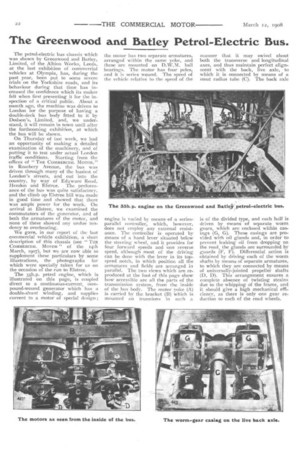The Greenwood and Batley Petrol-Electric Bus.
Page 24

If you've noticed an error in this article please click here to report it so we can fix it.
The petrol-electric bus chassis which was shown by Greenwood and Batley, Limited, of the Albion Works, Leeds, at the last exhibition of commercial vehicles at Olympia, has, during the past year, been put to some severe trials on the Yorkshire roads, and its behaviour during that time has increased the confidence which its maker felt when first presenting it for the inspection of a critical public. About a month ago, the machine was driven to London for the purpose of haying a double-deck bus body fitted to it by Dodson's, Limited, and, we understand, it will remain in town until after the forthcoming exhibition, at which the bus will be shown.
On Thursday of Last week, we had an opportunity of making a detailed examination of the machinery, and of putting it to test under actual London traffic conditions. Starting from the offices of "THE COMMERCIAL MOTOR," in Rosebcry Avenue, the bus was driven through many of the busiest of London's streets, and out into the country, by way of Edgware Road, Hendon and Elstree. The performance of the bus was quite satisfactory, and the climb up Elstree hill was made in good time and showed that there was ample power for the work. On arrival at Elstree, we examined the commutators of the generator, and of both the armatures of the motor, and none of these showed any undue tendency to overheating.
We gave, in our report of the last commercial vehicle exhibition, a short description of this chassis (see " THE COMMERCIAL MOTOR" of the rzi.th March, 1907), but we are now able to supplement these particulars by some illustrations, the photographs for which were specially taken for us on the occasion of the run to Elstree.
The 35h.p. petrol engine, which is illustrated on this page, is coupled direct to a continuous-current, compound-wound generator which has a double-shunt winding, and supplies current to a motor of special design ; the motor has two separate armatures, arranged within the same yoke, and these are mounted on D.W.M. hall bearings. The motor has four poles, and it is series wound. The speed of the vehicle relative to the speed of the
engine is varied by means of a seriesparallel controller, which, however, does not employ Any external resistance. The controller is operated by means of a hand lever situated below the steering wheel, and it provides for four forward speeds and one reverse speed, although most of the driving can be done with the lever in its topspeed notch, in which position all the armatures and fields are arranged in parallel. The two views which are reproduced at the foot of this page show how accessible are all the parts of the transmission system, from the inside of the bus body. The motor yoke (A) is carried by the bracket (B) which is mounted on trunnions in such a manner that it may swivel about both the transverse and longitudinal axes, and thus maintain perfect alignment with the back, live axle, to which it is connected by means of a stout radius tube (C). The back axle
is of the divided type, and each half is driven by means of separate worm gears, which are enclosed within casings (G, G). These casings are provided with oil glands and, in order to prevent leaking oil from dropping on the road, the glands are surrounded by guards (F, F). Differential action is obtained by driving each of the worm shafts by means of separate armatures, to which they are connected by means of universally-jointed propeller shafts (D, D). This arrangement ensures a complete absence of twisting strains due to the whipping of the frame, and it should give a high mechanical efficiency, as there is only one gear reduction to each of the road wheels.


























